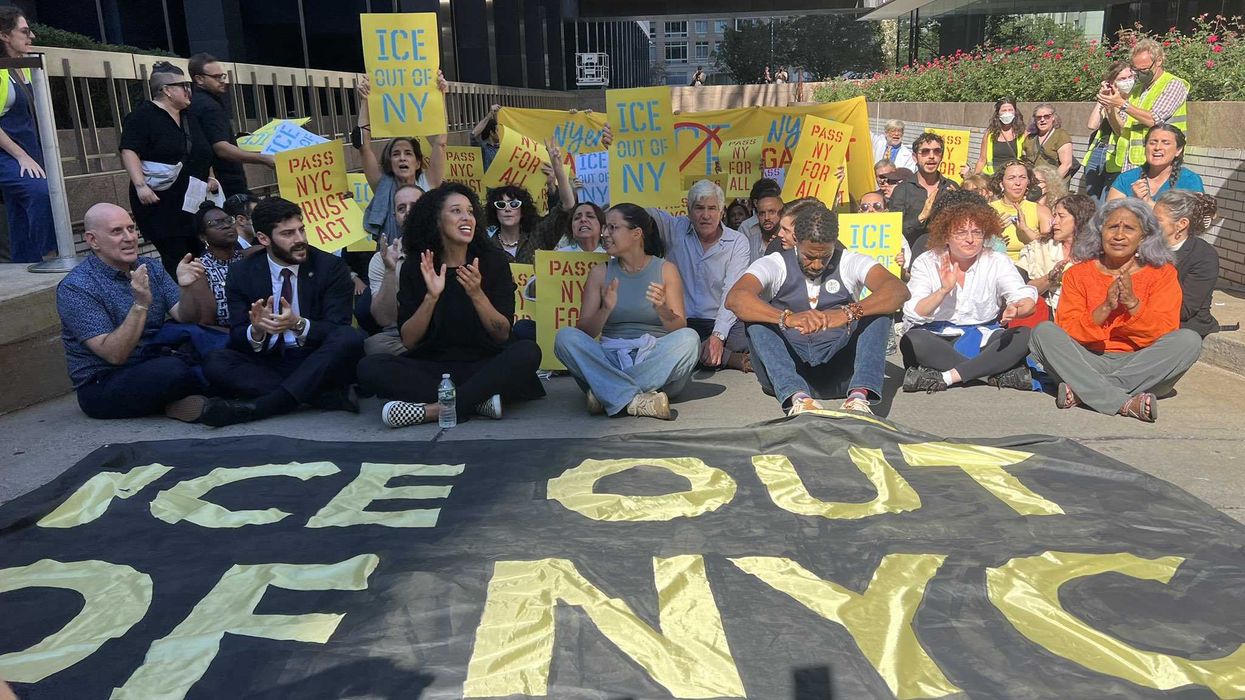Over 70 Arrested, Including City Officials, During Protests Against ICE Detention in NYC
"We are talking about people fleeing violence and terror, and we are subjecting them to violence and terror," said New York City Comptroller Brad Lander, who was arrested for the second time this summer for attempting to block ICE.
Department of Homeland Security police arrested 11 New York state lawmakers on Thursday as they demanded access to a secretive immigrant detention facility in Lower Manhattan.
As The City reports:
The arrests at 26 Federal Plaza happened after an hour-long standoff, with the lawmakers refusing to leave the hallway outside the lockup, banging on the locked doors, and eventually sitting down to chant and sing before they were hauled off in zip ties.
All 11 have been released. Those arrested were city Comptroller Brad Lander along with state Senators Jabari Brisport, Gustavo Rivera and Julia Salazar and Assemblymembers Robert Carroll, Emily Gallagher, Jessica Gonzalez Rojas, Marcela Mitaynes, Steve Raga, Tony Simone and Claire Valdez.
The lawmakers were among at least 71 people arrested at the facility, according to a statement from the Department of Homeland Security (DHS). Others included immigrants’ rights activists and religious leaders who held a sit-in to block Immigration and Customs Enforcement (ICE) vans from entering and exiting the facility with detainees.
The agency has previously denied that an immigrant detention site exists at 26 Federal Plaza, a federal building that contains DHS and FBI offices as well as one of New York City's main immigration courts.
But in July, videos obtained by the New York Immigration Coalition confirmed accounts that it was confining people in wretched conditions.
(Video: The Guardian, via the New York Immigration Coalition)
Those clips, first reported by The City, showed around two dozen men in a fluorescent-lit room without beds. Several of them were shown lying on the ground under aluminum emergency blankets. The camera showed two toilets in the same room, separated from the living quarters by nothing but a short wall.
One of the men described the conditions: "They haven’t given us food, they haven’t given us medicine. We’re cold. There are people who’ve been here for 10, 15 days inside. We’re just waiting.”
New York City public advocate Jumaane Williams, who would become the first person arrested on Thursday, explained why he was helping to block the driveway to the facility.
"I think everybody can now see that everything going on behind us is not only illegal, it's inhumane, and has nothing to do with public safety," he said, with chants echoing behind him. "Those of us who have a little bit more privilege have to step up and do our best to protect those who have even less."
New York City Comptroller Brad Lander—a top ally of the Democratic nominee for mayor, Zohran Mamdani—was arrested for the second time at 26 Federal Plaza this summer. In June, he was grabbed by masked agents there while he escorted a defendant out of immigration court.
"I've been here more than a dozen times, and every single time, I have seen a lawless abduction," Lander said while sitting in a circle with protesters inside the building. "We are talking about people fleeing violence and terror, and we are subjecting them to violence and terror."
In a statement responding to the protests, Tricia McLaughlin, a spokesperson for the DHS, accused the immigrants inside the facility of being gang members, possessing fentanyl, or having a gun, though she did not identify any of the detainees.
According to the most recent immigration data, about 71% of those held in ICE detention have no criminal convictions, while most of those who do have committed only minor offenses. Data from June showed that just 7% of those taken into custody have violent criminal convictions.
McLaughlin blamed Lander for starting the "chaos" at the facility, which she said led to the arrest of "71 agitators and sanctuary politicians.”
Long known as a "sanctuary city," New York City has laws on the books forbidding agencies, including the New York Police Department (NYPD), from cooperating with federal immigration enforcement unless the person ICE seeks to detain has been convicted of a serious crime and ICE officials present a judicial warrant.
However, facing a lawsuit and aggressive pressure campaign from the Trump administration, Mayor Eric Adams has sought to loosen that policy and increase collaboration with federal authorities.
Thursday's protests come as ICE ramps up arrests and detentions to record numbers across the state of New York, which the protesters argued the state legislature has done little to combat.
Among the protesters' demands was for the legislature to pass the New York For All Act, which would limit state agencies' ability to collaborate with ICE and other federal agencies. They also called on the city council to pass the NYC Trust Act, which would allow individuals to sue the NYPD and the city's Department of Corrections for collaborating with ICE in violation of the city's sanctuary laws.
Tiffany Cabán, a city council member who was arrested outside the plaza, addressed the press while being led away by a pair of police officers.
"We need to get ICE out of New York," Cabán said. "We need to make sure that every detainee in Federal Plaza is released. There is a humanitarian crisis. They're being tortured. We need to, at the state and city level, pass laws to make sure that we remain a sanctuary city."


